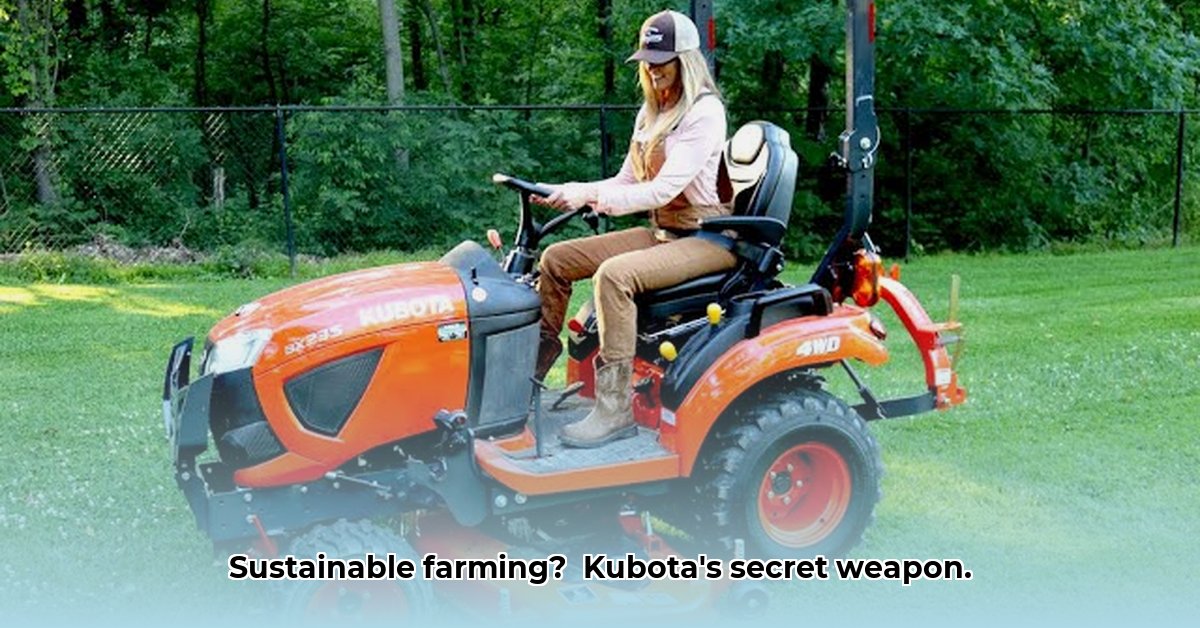
Is a Kubota Belly Mower Right for Your Sustainable Farm?
Choosing the right mowing equipment is crucial for sustainable farming practices. Kubota belly mowers (mid-mount mowers or MMMs), particularly those attached to Kubota BX series tractors, offer precision and maneuverability, making them ideal for smaller farms or properties with obstacles like trees or fences. However, their suitability depends heavily on your specific needs and farm layout. This comparative review will help you determine whether a Kubota belly mower is the right tool for your sustainable operation. For more information on Kubota equipment, visit this helpful resource.
Kubota Belly Mowers: A Comparative Analysis
Kubota belly mowers excel in tight spaces, allowing for precise cuts around obstacles. Their compact size makes them suitable for smaller farms, typically those under 6 acres. However, their lower ground clearance may pose challenges in uneven terrain, and their turning radius can be limited compared to other mowing options. Let's compare them with other popular choices:
| Feature | Kubota Belly Mower (MMM) | Rear-Mount Mower | Zero-Turn Mower |
|---|---|---|---|
| Maneuverability | Excellent in tight spaces; limited turning radius | Moderate (depends on size and turning radius) | Excellent |
| Ground Clearance | Lower; potential issues on slopes | Generally higher | High |
| Cost | Moderately priced; cost-effective used options | Usually more expensive | Most expensive |
| Versatility | Can be used with other implements | Generally used for mowing only | Primarily used for mowing |
| Soil Compaction | Higher risk if not used properly | Moderate risk | Low risk |
"The choice of mower depends entirely on the farm's unique characteristics," says Dr. Emily Carter, Agricultural Engineering Professor at the University of California, Davis. "A Kubota BX with MMM offers precision but lacks the speed and terrain adaptability of some other options."
This highlights the importance of a thorough evaluation of your specific needs. Are you primarily focused on maintaining neat, close-quarter areas like an orchard, or do you have large, open fields? The answer will greatly influence your choice.
A Practical Guide to Using Your Kubota Belly Mower
Effective and safe operation of your Kubota belly mower is key to maximizing its benefits and avoiding damage. Follow these steps:
Pre-Mow Inspection: Check for debris on the mower deck, inspect blade sharpness, and ensure all fluids are at correct levels. Dull blades lead to uneven cuts and can damage both the mower and the turf. Remember, a sharp blade is not only more efficient but also minimizes soil compaction. This step can save you time and money.
Attaching the Mower: Securely attach the mower to your tractor's mid-mount system, following the manufacturer's instructions carefully. Proper attachment is vital for safety and optimal performance. Improperly attached mowers can cause severe damage or injury.
Mowing Techniques: Maintain a consistent mowing speed, avoiding scalping (removing too much soil) and overlapping passes for a neat, even cut. A consistent speed ensures even cutting and minimal soil disturbance.
Navigating Obstacles: Utilize the maneuverability of the MMM to carefully navigate around obstacles, taking your time and adjusting your approach as needed. "Slow and steady wins the race," advises seasoned farmer, John Miller, owner of Miller Family Farms.
Post-Mow Cleanup: After each use, remove debris from the mower deck and blades, preventing rust and prolonging the mower's lifespan. Regular cleaning is essential for mower longevity and prevents the buildup of grass, dirt and debris that could lead to performance issues.
Long-Term Considerations and Sustainable Practices
Sustainable farming requires a long-term perspective. Consider these factors when choosing and using a Kubota belly mower:
Regular Maintenance: Prevent costly repairs and extend the lifespan of your equipment. Regular maintenance minimizes downtime and ensures peak performance.
Tire Selection: Pneumatic tires generally cause less soil compaction than solid turf tires, benefiting soil health. The use of pneumatic tires is a key consideration for sustainable practices.
Appropriate Mowing Height: Avoiding scalping helps maintain healthy topsoil and supports vigorous grass growth. Overly aggressive mowing practices can damage topsoil.
Proper Operation: Minimize soil compaction by using proper mowing techniques, limiting overlaps, and maintaining a consistent speed. Proper operation of your equipment is critical to the long-term sustainability of your farming operation.
A Kubota belly mower can be a valuable asset in a sustainable farm, but its suitability depends on your specific circumstances. Thorough research and careful consideration of your needs are crucial before making a purchase.